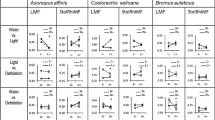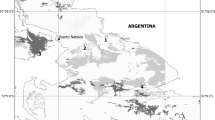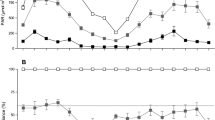Abstract
The canopy architecture of herbaceous communities has received little attention despite its obvious relevance for how plants interact. The objective of this study was to determine how the position of species within the canopy of a species-rich grassland depends on nutrient availability, light availability, and mowing regime. To enhance the generality of the results, species were classified into four growth-form groups according to two important morphological traits – narrow vs. wide leaves, leafy vs. leafless stem - grasses, sedges, upright forbs and rosette forbs. Vertical structure of the canopy was examined by point quadrat sampling of 40×40 cm permanent plots, treated by fertilization, additional illumination and mowing. As expected, fertilization and cessation of mowing allowed plants to grow taller, an effect of additional illumination was not detected. The relative height of species in the canopy was related to their leaf and stem morphology – species with narrow leaves and/or with a leafy stem were significantly taller. In addition, each growth-form group had a characteristic relative height: grasses > sedges > upright forbs > rosette forbs. All the experimental treatments led to a smaller number of more clearly distinguishable canopy strata with certain growth-form group(s) dominating in each. In (non-fertilized, non-illuminated and mown) control plots the dominance of grasses in the upper canopy layers was the most obvious - the remaining plants tended to improve their vertical position with all manipulations. The two contrasting growth-form groups – grasses and rosette forbs – responded similarily to illumination, becoming relatively shorter with added light. Sedges and upright forbs used additional light to `improve' their position in the canopy.
Similar content being viewed by others
References
Aerts, R. 1996. Nutrient resorption from senecing leaves of perennials: are there general patterns?, J. Ecol. 84: 597–608.
Aerts, R., Boot, R. G. A. & van der Aart, P. J. M. 1991. The relation between above-and belowground biomass allocation patterns and competitive ability. Oecologia 87: 551–559.
Ashby, M. 1961. Introduction to plant ecology. Macmillan, London.
Barkman, J. J.: 1988. New systems of plant growth forms and phenological plant types. Pp. 9–44. In: Werger, M. J. A., van der Aart, P. J. M., During, H. J. & Verhoeven, J. T. A. (eds), Plant form and vegetation structure. SPB Academic Publishing, the Hague.
Bazzaz, F. A. 1990. Plant-plant interactions in successional environments. Pp. 239–263. In: Grace, J. and Tilman, D. (eds), Perspectives on plant competition. Academic Press, New York.
Berendse, F. 1985. The effect of grazing on the outcome of competition between plant species with different nutrient requirements. Oikos 44: 35–39.
Bonser, S. P. & Reader, R. S. 1995. Plant competition and herbivory in relation to vegetation biomass. Ecology 76: 2178–2183.
Casal, J. J., Sanchez, R. A. & Deregibus, V. A. 1987. The effect of light quality on shoot extension growth in three species of grasses. Ann. Bot. 59: 1–7.
Cernusca, A. 1976. Energy exchange within individual layers of a meadow. Oecologia 23: 141–149.
Cody, M. L. 1986. Structural niches in plant communities. Pp. 381–405. In: Diamond, J. and Case, T. J. (eds), Community ecology. Harper and Row, New York.
Cody, M. L. 1991. Niche theory and plant growth form. Vegetatio 97: 39–55.
Connolly, J. & Wayne, P. 1996. Asymmetric competition between plant species. Oecologia 108: 311–320.
Cowling, R. M., Mustart, P. J., Laurie, H. & Richards, M. B. 1994. Species diversity; functional diversity and functional redundancy in fynobs communities. South Afr. J. Sci. 90: 333–337.
de Kroon, H. & Knops, J. 1990. Habitat exploration through morphological plasticity in two chalk grassland perennials. Oikos 59: 39–49.
Diaz, S., Acosta, A. & Cabido, M. 1994. Community structure in montane grassland of central Argentina in relation to land use. J. Veg. Sci. 5: 483–488.
Dietz, H., Steinlein, T. & Ullmann, I. 1998. The role of growth form and correlated traits in competitive ranking of six perennial ruderal plant species grown in unbalanced mixtures. Acta Oecologica 19: 25–36.
Eek, L. & Zobel, K. 1997. Effects of additional illumination and fertilization on seasonal changes in fine-scale grassland community structure. J. Veg. Sci. 8: 225–234.
Ellenberg, H., Weber, H. E., Düll, R., Wirth, V., Werner, W. & Paulißen, D. 1991. Zeigerwerte von Pflanzen in Mitteleuropa. Scripta Geobotanica 18: 1–248.
Gaudet, C. L. & Keddy, P. A. 1988. A comparative approach to predicting competitive ability from plants traits. Nature 334: 242–243.
Gimingham, C. H. 1951. The use of life form and growth form in the analysis of community structure, as illustrated by a comparison of two dune communities. J. Ecol. 39: 396–406.
Goldberg, D. E. & Werner, P. A. 1983. Equivalence of competitors in plant communities: a null hypothesis and a field experimental approach. Am. J. Bot. 70: 1098–1104.
Grime, J. P., Thompson, K., Hunt, R., Hodgson, J. G., Cornelissen, J. H. C., Rorison, I. H., Hendry, G. A. F., Ashenden, T. W., Askew, A. P., Band, S. R., Booth, R. E., Bossard, C. C., Campbell, B. D., Cooper, J. E. L., Davison, A. W., Gupta, P. L., Hall, W., Hand, D.W., Hannah, M. A., Hillier, S. H., Hodkinson, D. J., Jalili, A., Liu, Z., Mackey, J. M. L., Matthews, N., Mowforth, M. A., Neal, A. M., Reader, R. J., Reiling, K., Ross-Fraser, W., Spencer, R. E., Sutton, F., Tasker, D. E., Thorpe, P. C., Whitehouse, J. 1997. Integrated screening validates primary axes of specialisation in plants. Oikos 79: 259–281.
Grime, J. P., Crick, J. C. & Rincon, J. E. 1986. The ecological significance of plasticity. Pp. 5–29. In: Jennings, D. H. & Trewavas, A. J. (eds), Plasticity in plants. Company of Biologists, Cambridge.
Halloy, S. 1990. A morphological classification of plants, with special reference to the New Zealand alpine flora. J. Veg. Sci. 1: 291–304.
Harley, J. L. & Harley, E. L. 1987. A check-list of mycorrhiza in the British flora. New Phytol. 105: 1–102.
Henry, H. A. L. & Aarssen L.W. 1997. On the relationship between shade tolerance and shade avoidance strategies in woodland plants. Oikos 80: 575–582.
Idso, S. B. & de Wit, C. T. 1970. Light relations in plant canopies. Applied Optics 9: 177–184.
Johnson, I. R. & Thornley, J. H. M. 1987. A model of shoot:root partitioning with optimal growth. Ann. Bot. 60: 133–142.
Kikuzawa, K. & Umeki, K. 1996. Effect of canopy structure on degree of asymmetry of competition in two forest stands in nothern Japan. Ann. Bot. 77: 565–571.
Klepper, B. 1991. Root-shoot realtionships. Pp. 265–286. In: Waisel, Y., Eshel, A. & Kafkafi, U. (eds), Plant roots. The hidden half. Marcel Dekker, New York.
Körner, C. 1991. Some often overlooked plant characteristics as determinants of plant growth: a reconsideration. Funct. Ecol. 5: 162–173.
Körner, C. 1995. Scaling from species to vegetation: the usefulness of functional groups. Pp. 117–140. In: Schulze, E. D. & Mooney, H. A. (eds), Biodiversity and Ecosystem Function. Springer-Verlag, Berlin.
Krall, H. & Pork, K. 1970. Laelatu puisniit. Pp. 115–127. In: Kumari, E. (ed.), Lääne-Eesti rannikualade loodus. Valgus, Tallinn.
Kull, O. & Aan, A. 1997. The relative share of graminoid and forb life-forms in a natural gradient of herb layer productivity. Ecography 20: 146–154.
Kull, K. & Zobel, M. 1991. High species richness in an Estonian wooded meadow. J. Veg. Sci. 2: 711–714.
Kull, K. & Zobel, K. 1995. Kas on veel ruumi? Ei, kõik on täis. Eesti Loodus 2: 33–35.
Kull, O., Aan, A. & Sõelsepp, T. 1995. Light interception, nitrogen and leaf mass distribution in multilayer community. Funct. Ecol. 9: 589–595.
Lavorel, S., McIntyre, S., Landsberg, J. & Forbes, T. D. A. 1997. Plant functional classifications: from general groups to specific groups based on response to disturbance. Trends Ecol. Evol. 12: 474–478.
Marrs, R. H., Bravington, M. & Rawes, M. 1988. Long-term vegetation change in the Juncus squarrosus grassland at Moor House, northern England. Vegetatio. 76: 179–187.
McIntyre, S., Lavoral, S. & Tremont R. M. 1995. Plant lifehistory attributes: their relationship to disturbance response in herbaceous vegetation. J. Ecol. 83: 31–44.
Mitchley, J. 1988. Control of relative abundance of perennials in chalk grassland in Southern England. II. Vertical canopy structure. J. Ecol. 76: 341–350.
Mitchley, J. & Willems, J. H. 1995. Vertical canopy structure of Dutch chalk grasslands in relation to their management. Vegetatio 117: 17–27.
Mooney, H. A. & Winner, W. E. 1991. Partitioning response of plants to stress. Pp. 129–141. In: Mooney, H. A., Winner, W. E. & Pell, E. J. (eds), Response of plants to multiple stresses. Academic Press, San Diego.
Nadelhoffer, K. J., Aber, J. D. & Melillo, J. M. 1985. Fine roots, net primary production, and soil nitrogen availability: a new hypothesis. Ecology 66: 1377–1390.
Oikawa, T. & Saeki, T. 1977. Light regime in relation to plant population geometry. I. A Monte-Carlo simulation of light microclimates within a random distribution foliage. Bot. Mag. Tokyo 90: 1–10.
Olff, H. 1992. Effects of light and nutrient availability on dry matter and N allocation in six successional grassland species. Oecologia 89: 412–421.
Pärtel, M., Zobel, M., Zobel, K. & van der Maarel, E. 1996. The species pool and its relation to species richness: evidence from Estonian plant communities. Oikos 75: 111–117.
Pechaèkova, S. & Krahulec, F. 1995. Efficient nitrogen economy: key to the success of Polygonum bistorta in an abandoned mountain meadow. Folia Geobotanica Pytotaxonomica 30: 211–222.
Pickett, S. T. A., Kolasa, J. Armesto, J. J. & Collins, S. L. 1989. The ecological concept of disturbance and its expression at various hierarchical levels. Oikos 54: 129–136.
Pokarzhevskaya, G. A. 1995. Morphological analysis of Alpine communities of the north-western Caucasus. Folia Geobotanica Phyottaxonomica 30: 179–210.
Pons, T. L., van Rijnberk, H., Scheurwater, I. & var der Werf, A. 1993. Importance of the gradient in photosynthetically active radiation in a vegetation stand for leaf nitrogen allocation in two monocotyledons. Oecologia 95: 416–424.
Saeki, T. 1960. Interrelationships between leaf amount, light distribution and total photosynthesis in plant community. Bot. Mag. Tokyo 73: 55–63.
SAS Institute Inc. 1992. SAS. The technical report P-229
SAS/STAT. Software: changes and enchancements, release 6.07, SAS Institute Inc., Cary, pp. 289–366.
Tappeiner, U. & Cernuska, A. 1996. Microclimate and fluxes of water vapour, sensible heat and carbon dioxide in structurally differing subalpine plant communities in the Central Caucasus. Plant, Cell Env. 19: 403–417.
Tilman, D. 1987. Secondary succession and the pattern of plant dominance along experimental nitrogen gradients. Ecol. Monogr. 57: 189–214.
Tilman, D. 1990. Constraints and tradeoffs: toward a predictive theory of competition and succession. Oikos 58: 3–15.
Tooming, H. 1977. Solar radiation and crop formation. Gidrometeoizdat, Leningrad. (in Russian)
Turtzin, S. N. 1978. Canopy structure and potential light competition in two adjacent annual plant communities. Ecology 59: 161–167.
Weiher, E. & Keddy, P. A. 1995. Assembly rules, null models, and trait dispersion: new question from old patterns. Oikos 74: 159–164.
Weiner, J. 1990. Asymmetric competition in a plant populations. Trends Ecol. Evol. 5: 360–364.
Willems, J. H. & Nieuwstadt, M. G. L. 1996. Long-term after effects of fertilization on above-ground phytomass and species diversity in calcareous grassland. J. Veg. Sci. 7: 177–184.
Willems, J. H., Peet, R. K. & Bik, L. 1993. Changes in chalkgrassland structure and species richness from selective nutrient additions. J. Veg. Sci. 4: 203–212.
Willms, W. D. 1988. Response of rough fescue (Festuca scabrella) to light, water, temperature, and litter removal, under controlled conditions. Can. J. Bot. 66: 429–434.
Yokozawa, M & Hara, T. 1995. Foliage profile, size structure and stem diameter-plant height relationship in crowded plant populations. Ann. Bot. 76: 271–285.
Zobel, K., Moora, M. Brown, V. K., Niemelä, P. & Zobel, M. 1997. Secondary succession and herbivory in a subarctic grassland: community structure and diversity. Ecography 20: 595–604.
Zobel, M. 1997. The relative role of species pools in determining plant species richness: an alternative explanation of species coexistence?. Trends Ecol. Evol. 12: 266–269.
Zobel, M., Suurkask, M., Rosén, E. & Pärtel, M. 1996. The dynamics of species richness in an experimentally restored calcareous grassland. J. Veg. Sci. 7: 203–210.
Author information
Authors and Affiliations
Rights and permissions
About this article
Cite this article
Liira, J., Zobel, K. Vertical structure of a species-rich grassland canopy, treated with additional illumination, fertilization and mowing. Plant Ecology 146, 183–193 (2000). https://doi.org/10.1023/A:1009811117681
Issue Date:
DOI: https://doi.org/10.1023/A:1009811117681




